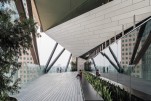In Honour of the Reformer

Mexico or the United Mexican States is the state in North America, which capital is the rapidly developing Mexico City. in Mexico City are located 47 percent from the total country’s key manufacturing enterprises. Population of the capital according to official figures currently is about 9 million people and its urban economy is the eight in the world by size. The main street of Mexico City is the Reforma Avenue or the Paseo de la Reforma, named after the liberal reforms of President Juarez. The avenue was designed in the 1860s modeled on the straight, spacious and wide Parisian avenues and boulevards organized in the French capital by efforts of Baron Georges Eugène Osman on request of Napoleon.
Prospect Reforma has come down to our days filled up with many monuments such as the one dedicated to Christopher Columbus and the tenth ruler of Tenochtitlan Cuitláhuac, the Angel of Independence, the fountain dedicated to “Diana-the hunter” and others.
At the very end of the street is located the business district of Mexico City which deserves special attention according to the quality of its contemporary architecture and for several years remains an extremely attractive place for international investment. Among the other interesting buildings in this area there are four new skyscrapers engineering work for which was done from offices in London and New York of the very well-known in their field team Arup. All four towers are distinguished by innovative structural solutions that have been developed individually for each of them, taking into account peculiarities of construction in a unique urban landscape.
Mexico City is a capital with rich culture and a lot of historical architecture in the city center. For developers although there are not many sites left that would meet growing needs of the commercial market, and those that are allowed to be built with high-rise buildings are often already occupied by houses of medium height next to which one fulfilling all the norms finally can build. Of course this situation is potentially difficult for architects and engineers, who are forced to work on very narrow areas, often also of an irregular shape. Additional problems are also caused by large roads adjacent to such sites, underground infrastructure and other constantly going on construction works.
Full content of this issue you can read here
The full version of the article can be read in our printed issue, also you can subscribe to the web-version of the magazine
 Text by ELIZAVETA KLEPANOVA
Text by ELIZAVETA KLEPANOVA


